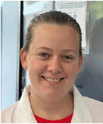Antimicrobial resistance in production animals
Darren J. Trott A * , Andrea McWhorter B , Kylie Hewson C , Rebecca Abraham D and Sam Abraham DA
B
C
D

Prof. Darren Trott is a veterinarian and microbiologist with research interests including zoonotic, companion and production animal bacterial diseases, focusing on molecular epidemiology, microbial pathogenesis, microbial ecology, antibiotic resistance and development and repurposing of new antimicrobials. He is the inaugural Director of the Australian Centre of Antimicrobial Resistance Ecology. He teaches veterinary microbiology, antimicrobial chemotherapy and antimicrobial stewardship to veterinary science students and co-ordinates the DVM-1 Clinical Research Project. |

Andrea McWhorter is a microbiologist specialising in poultry health and zoonotic foodborne pathogens. Her research also extends to understanding the transmission of foodborne pathogens from farms to the food supply chain, leading to human disease. Andrea collaborates closely with the egg and chicken meat industries to address the challenges of improving bird health and mitigating zoonotic bacteria in food. |

Kylie Hewson has worked for over 15 years in the Australian agriculture sector as a scientist, research manager, policy manager and advocate for ensuring quality science is not only produced, but also made accessible and able to be used in setting policy and achieving meaningful impact. Kylie has represented industry on several high-level cross-sectoral and government committees, with extensive experience as Chair, across issues such as biosecurity, food safety, animal health and antimicrobial stewardship. |

Rebecca Abraham is an early career researcher with experience in bacterial AMR surveillance and drug discovery for microorganisms including fungi, bacteria, viruses and parasites. She is involved in the development and use of automated high-throughput screening assays to identify novel antimicrobial compounds and to detect bacterial AMR. |

Prof. Sam Abraham is Professor of Microbiology and Director, Centre for Biosecurity and One Health, Harry Butler Institute, Murdoch University. He leads the Antimicrobial Resistance and Infectious Disease Laboratory. His research encompasses AMR, robotics, genomics, One Health and veterinary microbiology. |
Abstract
There is growing recognition of the significant role food production animals play in the dissemination of antimicrobial-resistant bacteria. This issue is particularly relevant in the realm of food production, where the administration of antibiotics of importance to human health to animals can foster the emergence of resistant bacterial strains that may be transmitted to humans through the food supply chain. Further, resistance can develop to antibiotics of importance for animal health which can create health and productivity issues. Cross-sectional surveys of Australian food animal production systems have revealed that very low levels of antimicrobial resistance (AMR) are present in key bacterial species. Expansion of AMR surveillance in food production systems is, however, needed to improve the detection sensitivity of emerging resistances of importance to human and animal health. Scalable high throughput technologies, such as the robotic antimicrobial susceptibility platform (RASP), represents a step-fold change in the capacity to accurately detect AMR. Enhanced surveillance along with improved biosecurity, industry engagement and antimicrobial stewardship will contribute to maintaining low levels of AMR in Australia’s food production systems.
Keywords: animal production, antimicrobial resistance, antimicrobial susceptibility testing, critically important antimicrobials, food-producing animals, livestock, robotic processing, surveillance.
 Prof. Darren Trott is a veterinarian and microbiologist with research interests including zoonotic, companion and production animal bacterial diseases, focusing on molecular epidemiology, microbial pathogenesis, microbial ecology, antibiotic resistance and development and repurposing of new antimicrobials. He is the inaugural Director of the Australian Centre of Antimicrobial Resistance Ecology. He teaches veterinary microbiology, antimicrobial chemotherapy and antimicrobial stewardship to veterinary science students and co-ordinates the DVM-1 Clinical Research Project. |
 Andrea McWhorter is a microbiologist specialising in poultry health and zoonotic foodborne pathogens. Her research also extends to understanding the transmission of foodborne pathogens from farms to the food supply chain, leading to human disease. Andrea collaborates closely with the egg and chicken meat industries to address the challenges of improving bird health and mitigating zoonotic bacteria in food. |
 Kylie Hewson has worked for over 15 years in the Australian agriculture sector as a scientist, research manager, policy manager and advocate for ensuring quality science is not only produced, but also made accessible and able to be used in setting policy and achieving meaningful impact. Kylie has represented industry on several high-level cross-sectoral and government committees, with extensive experience as Chair, across issues such as biosecurity, food safety, animal health and antimicrobial stewardship. |
 Rebecca Abraham is an early career researcher with experience in bacterial AMR surveillance and drug discovery for microorganisms including fungi, bacteria, viruses and parasites. She is involved in the development and use of automated high-throughput screening assays to identify novel antimicrobial compounds and to detect bacterial AMR. |
 Prof. Sam Abraham is Professor of Microbiology and Director, Centre for Biosecurity and One Health, Harry Butler Institute, Murdoch University. He leads the Antimicrobial Resistance and Infectious Disease Laboratory. His research encompasses AMR, robotics, genomics, One Health and veterinary microbiology. |
References
1 Kirchhelle C (2018) Pharming animals: a global history of antibiotics in food production (1935–2017). Palgrave Commun 4, 96.
| Crossref | Google Scholar |
2 Anderson ES (1968) Drug resistance in Salmonella Typhimurium and its implications. Br Med J 3, 333-339.
| Crossref | Google Scholar | PubMed |
3 McEwan J (2007) A history of therapeutic goods regulation in Australia. Therapeutic Goods Administration, Canberra, ACT, Australia. https://www.tga.gov.au/sites/default/files/history-tg-regulation.pdf
5 Department of Health and Aged Care and Department of Agriculture, Fisheries and Forestry (2015) National AMR Strategy. Commonwealth of Australia. https://www.amr.gov.au/australias-response/national-amr-strategy
6 Department of Health and Aged Care and Department of Agriculture, Fisheries and Forestry (2020) Australia’s National Antimicrobial Resistance Strategy – 2020 and beyond. Commonwealth of Australia. https://www.amr.gov.au/resources/australias-national-antimicrobial-resistance-strategy-2020-and-beyond
7 Department of Health and Aged Care and Department of Agriculture, Fisheries and Forestry (2021) One Health Master Action Plan for Australia’s National Antimicrobial Resistance Strategy – 2020 and beyond. Commonwealth of Australia. https://www.amr.gov.au/resources/one-health-master-action-plan-australias-national-antimicrobial-resistance-strategy-2020-and-beyond
8 Department of Agriculture, Fisheries and Forestry (2023) Australia’s Animal Sector Antimicrobial Resistance: Action Plan 2023 to 2028. September 2023. DAFF, Canberra, ACT, Australia. https://www.agriculture.gov.au/sites/default/files/documents/australias-animal-sector-amr-action-plan-2023-2028.pdf
11 Mukerji S et al. (2017) Development and transmission of antimicrobial resistance among Gram-negative bacteria in animals and their public health impact. Essays Biochem 61, 23-35.
| Crossref | Google Scholar | PubMed |
12 Cheng AC et al. (2012) Control of fluoroquinolone resistance through successful regulation, Australia. Emerg Infect Dis 18, 1453-1460.
| Crossref | Google Scholar | PubMed |
13 Abraham S et al. (2014) Salmonella enterica isolated from infections in Australian livestock remain susceptible to critical antimicrobials. Int J Antimicrob Agents 43, 126-130.
| Crossref | Google Scholar | PubMed |
14 Pande VV et al. (2015) Antimicrobial resistance of non-typhoidal Salmonella isolates from egg layer flocks and egg shells. Int J Food Microbiol 203, 23-26.
| Crossref | Google Scholar | PubMed |
15 Barlow RS et al. (2015) Prevalence and antimicrobial resistance of Salmonella and Escherichia coli from Australian cattle populations at slaughter. J Food Prot 78, 912-920.
| Crossref | Google Scholar | PubMed |
16 Abraham S et al. (2019) Escherichia coli and Salmonella spp. isolated from Australian meat chickens remain susceptible to critically important antimicrobial agents. PLoS ONE 14, e0224281.
| Crossref | Google Scholar | PubMed |
17 O’Dea M et al. (2019) Genomic, antimicrobial resistance, and public health insights into Enterococcus spp. from Australian chickens. J Clin Microbiol 57,.
| Crossref | Google Scholar | PubMed |
18 Sodagari HR et al. (2019) Non-typhoidal Salmonella contamination in egg shells and contents from retail in Western Australia: Serovar diversity, multilocus sequence types, and phenotypic and genomic characterizations of antimicrobial resistance. Int J Food Microbiol 308, 108305.
| Crossref | Google Scholar | PubMed |
19 Shaban RZ et al. (2014) Surveillance and reporting of antimicrobial resistance and antibiotic usage in animals and agriculture in Australia. Report to the Department ofAgriculture. Griffith University and University of Adelaide, Australia. https://www.agriculture.gov.au/agriculture-land/animal/health/amr/surveillance-antimicrobial-resistance#daff-page-main
20 Sahibzada S et al. (2018) Emergence of highly prevalent CA-MRSA ST93 as an occupational risk in people working on a pig farm in Australia. PLoS ONE 13, e0195510.
| Crossref | Google Scholar | PubMed |
21 Abraham S et al. (2020) Emergence of fluoroquinolone-resistant Campylobacter jejuni and Campylobacter coli among Australian chickens in the absence of fluoroquinolone use. Appl Environ Microbiol 86, e02765-19.
| Crossref | Google Scholar | PubMed |
22 Abraham S et al. (2015) First detection of extended-spectrum cephalosporin- and fluoroquinolone-resistant Escherichia coli in Australian food-producing animals. J Glob Antimicrob Resist 3, 273-277.
| Crossref | Google Scholar | PubMed |
23 Abraham S et al. (2018) Dissemination and persistence of cephalosporin- and cephalosporin-resistance encoding IncI1-bla CTXM-1 plasmid among Escherichia coli in pigs. ISME J 12, 2352-2362.
| Crossref | Google Scholar | PubMed |
24 World Health Organization (2015) WHA68.7: Global Action Plan onAntimicrobial Resistance. In Sixty-Eighth World Health Assembly, 26 May 2015, Geneva, Switzerland. WHO. https://apps.who.int/gb/ebwha/pdf_files/WHA68/A68_R7-en.pdf
25 Truswell A et al. (2021) Robotic antimicrobial susceptibility platform (RASP): a next-generation approach to One Health surveillance of antimicrobial resistance. J Antimicrob Chemother 76(7), 1800-1807.
| Crossref | Google Scholar | PubMed |


